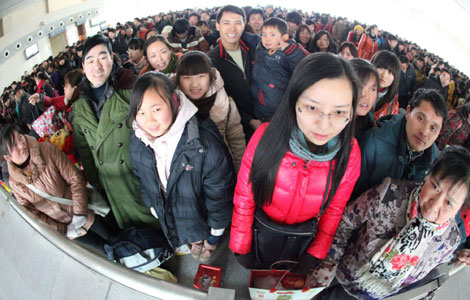Take out the old, bring in the new
Updated: 2012-01-30 08:55
By Yu Ran (China Daily)
|
|||||||||||
The famously competitive Shanghai is attempting a business makeover to boost innovation
SHANGHAI - Shanghai's development from a manufacturing base into a services center is a natural move for the cosmopolitan city, which has always harbored ambitions to rival New York and London as a global financial hub.
Such a progression is widely seen to have become all the more pressing since China, increasingly concerned about the impact of escalating property prices on the population, took away the punch bowl at the real-estate party last year. However, Shanghai's leaders seemed well prepared for the fallout if a subsequent slump affects the property market.
|
 |
|
A fashion parade in Shanghai. The nation, spearheaded by economic hubs such as Shanghai, is seeking innovation- and service industry-oriented growth. Mu Xiaomu / for China Daily |
On October 30, Han Zheng, the city's mayor, said that the contribution of the property market to Shanghai's economic development has been declining since 2005 and predicted that the downward trend will continue. The slack, he noted, has been more than made up for by the rapid growth of the services sector.
His prognosis was expanded by Yu Zhengsheng, the Communist Party Secretary of Shanghai, who said: "As the current major focus, Shanghai is keen to change the width and depth of economic development to push forward the restructuring of its industrial base at a faster pace."
This zeal for change is widely believed to have energized the tens of thousands of small- and medium-sized enterprises (SMEs), which have traditionally been the major driving force behind the service industry in the city.
"It has been the basis for the growth of SMEs to boost the service industry and offer essential services to consumers and large companies in Shanghai," said Song Xiaohui, an officer with the Shanghai SME Development and Service Center.
Take Happy Lemon Shanghai Ltd as an example: After starting out as a single kiosk in Shanghai in 2006, the tea-house chain has grown into a network of 60 outlets across the city. From Shanghai, the company has expanded to other cities in the area, with a network of 150 outlets with an average floor area of about 20 square meters each.
"We've noticed that more local people are fond of drinking healthy beverages such as tea-related products as a new type of lifestyle choice, especially for the young, so we give them what they want," said Happy Lemon's general manager Zhuang Qingman.
Zhuang said Happy Lemon is constantly experimenting with new formulas to suit the ever-changing tastes of younger consumers. "We need to keep abreast of the demands of our target customers, who are mostly in their 20s or younger," he said.
Economists and industry experts said there has been explosive growth in the number of SMEs in recent years, looking to cash in on the rapidly rising demand for a wide range of services, such as catering, personal care, retailing, logistics and travel by local consumers as well as those around the prosperous Yangtze River Delta region. In the process, the SMEs are changing the city's economic landscape, said Song.
|
 |
|
Visitors at a home decoration exhibition in Shanghai. The city aims to increase the share of the service industry to 65 percent of GDP in the next five years to meet the growing demand from its population of 23 million. Shen Jingwei / for China Daily |
Factory owners in the region are struggling to tap the domestic market as their export orders begin to shrink. Many of them have come to Shanghai looking for help in design and innovation. Their demands have spawned a multi-million yuan design service industry, spearheaded by many talented people who have overseas exposure.
Wang Yang, for instance, studied product design in Europe and returned to Shanghai, her hometown, a few years ago to start her own studio. Many others have followed in her footsteps and are helping to set the trend in packaging and product design that are becoming increasingly popular with local manufacturers and retailers.
In the last two decades, Shanghai has been one of the fastest-developing cities in the world. In 2010, the city's total GDP grew to 1.687 trillion yuan ($266.7 billion) with per capita GDP of 73,297 yuan.
As a means of speeding up the restructuring of the city, Shanghai aims to pay more attention to the tertiary industry, including retail, logistics, trading and consumption, but especially services.
"Moving from being manufacturing-based to service-focused is the best way of ensuring that local residents have a better, improved and higher quality of life in the near future, ahead of other cities in China," said Yu.
According to the city's 12th Five-Year Plan (2011-2015), the annual GDP growth rate will be maintained at 8 percent on average, and a number of innovative measures will be involved in the development.
Hot Topics
Kim Jong-il, Mengniu, train crash probe, Vaclav Havel, New Year, coast guard death, Internet security, Mekong River, Strait of Hormuz, economic work conference
Editor's Picks

|

|

|

|

|

|







